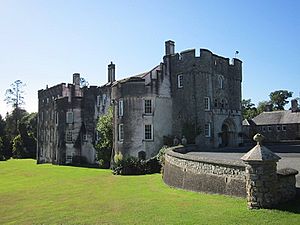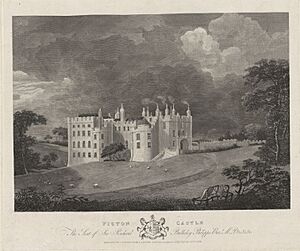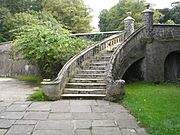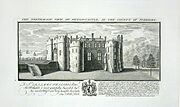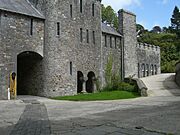Picton Castle facts for kids
Picton Castle (Welsh: Castell Pictwn) is an old castle in Pembrokeshire, Wales. It is near the town of Haverfordwest. A knight from Flanders first built it in the late 1200s. Later, the Wogan family owned it.
Today, the Picton Castle Trust manages the castle and its beautiful gardens. This trust is a charity that helps the public enjoy the site. The castle has a very unusual design and has been changed many times. It is a special building, listed as Grade I. Its gardens and park are also very important, listed as Grade II*.
Contents
Discover Picton Castle: A Welsh Gem
Picton Castle is a fascinating place with a long history. It stands in a beautiful part of Wales. The castle and its grounds offer a glimpse into the past.
A Look Back: Castle History
This area of Wales was once part of a Welsh kingdom. Around 1093, the Normans took control of much of South Wales. King Henry I of England then settled people from Flanders here in 1108. These Flemings helped protect the area for the King.
How Picton Castle Began
One Flemish leader, named Wizo, built Wiston Castle. He gave land to his followers. One of these followers received the land where Picton Castle now stands. This first castle builder is not well-known.
The current stone castle was built by Sir John Wogan. This happened between 1295 and 1308. The castle's design was quite unique. It did not have an open courtyard inside. Instead, seven round towers protected the main building. Two towers at the east end formed the gatehouse. The entrance led straight into the great hall.
Important Events and Changes
In 1405, French soldiers helped Owain Glyndŵr attack and capture the castle. Later, during the English Civil War in 1645, Parliament's forces took it over.
The Wogan family line ended in the 1400s. The castle then passed to the Philipps family through marriage. Sir John Philipps, who owned the castle in the 15th century, made many changes. He created a new entrance. In 1611, King James I sold special titles called baronetcies. Sir John Philipps bought one for his family.
Cesar Picton's Story
In 1672, a young black boy named Cesar Picton traveled with the Philipps family. He came from England to Picton Castle. He stayed at the castle and later chose "Picton" as his last name. This was likely because he lived there for a time.
Picton Castle Today
The castle stayed with the Philipps family for many years. It passed through different family members. Today, the Picton Castle Trust runs the estate. This is a charity that works to preserve the castle. The castle is a Grade I listed building. Its gardens and park are also very important, listed as Grade II*.
Explore the Castle and Gardens
Picton Castle is open to visitors every day. There is much to see and do.
Beautiful Gardens to Visit
The castle has over 40 acres of amazing gardens. These include a Walled Garden and a Jungle Garden. There are also Peach House Woods and a Fernery. The gardens are recognized by the Royal Horticultural Society. You can find a restaurant and a shop here too. You can even stay in self-catering rooms in the gatehouse lodges. The castle often hosts special events and workshops.
The Famous Picton Renoir
Picton Castle is home to a painting called the "Picton Renoir." This painting was featured on a BBC TV show called Fake or Fortune? in 2015. The show explored whether the painting was real. Art experts had different ideas about it. You can see this painting when you visit the castle.
Gallery
See also
- Castles in Great Britain and Ireland
- List of castles in England
- List of gardens in Wales
- Slebech


